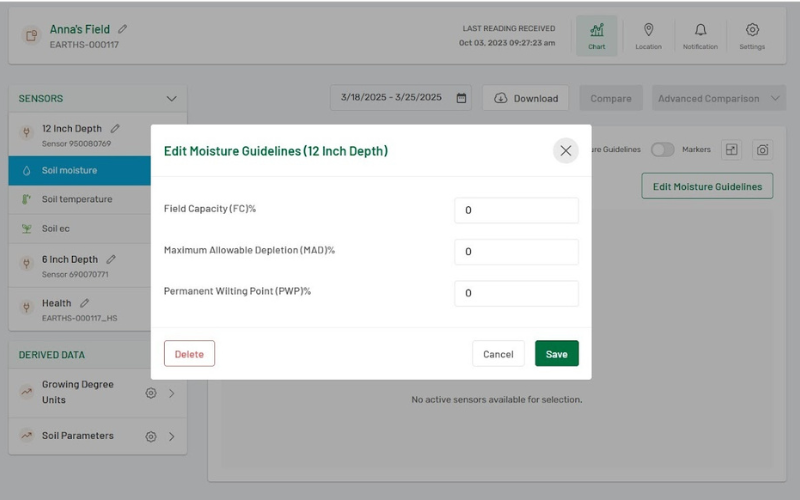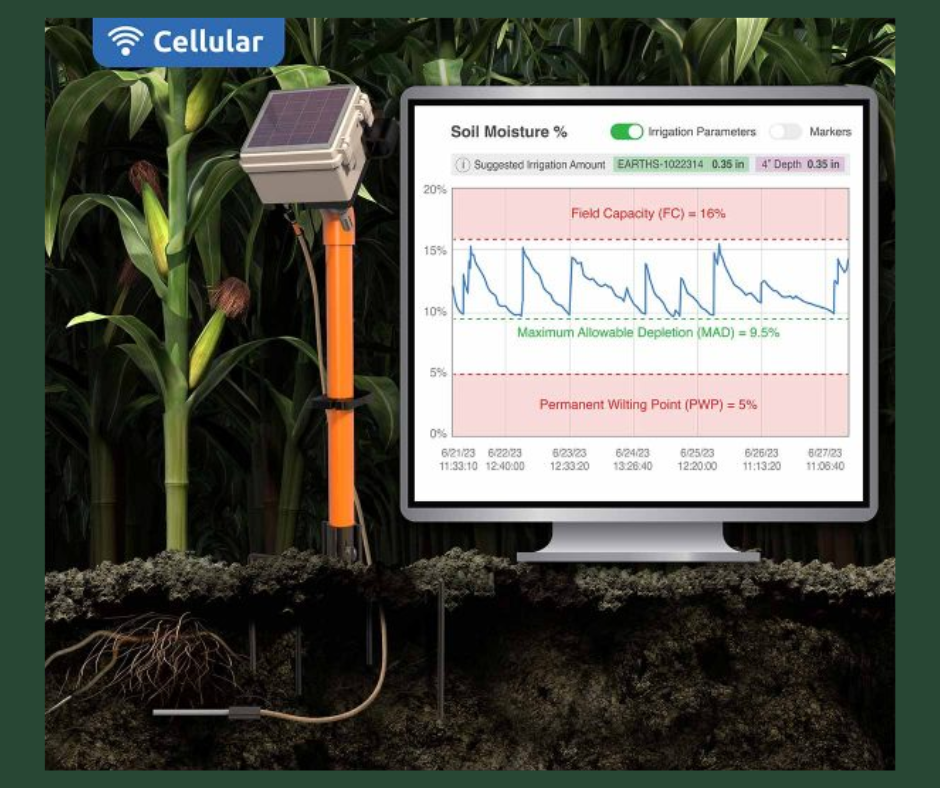Adequate soil moisture enables plants to survive. Optimal soil moisture encourages plants to thrive. At EarthScout, we encourage growers to determine their optimal soil moisture levels using in field data collected by soil moisture sensors.
Irrigation management allows growers to control their soil moisture levels, which can be made easier with the EarthScout Irrigation APP feature: Soil Moisture Guidelines.
Let’s dive into the topic of soil moisture and explore this new feature on our app and how it can positively impact your irrigation schedules. It’s amazing what a little applied knowledge can do!
Soil Moisture Defined
Soil moisture refers to the amount of water held in the soil’s pore spaces. It is a critical factor for plant growth, as it directly affects water availability for root uptake, influences nutrient transport, and impacts soil structure and microbial activity.
Agriculturists often measure soil moisture to optimize irrigation, assess drought conditions, and support sustainable agricultural practices. Its management is essential for improving crop productivity and maintaining soil health.
How Does Soil Moisture Affect Crop Yields?
Soil moisture significantly impacts crop yields as it directly influences various aspects of plant growth and development:
- Water Availability: Plants rely on soil moisture for water uptake through their roots. Insufficient moisture can lead to drought stress, stunted growth, and lower yields, while excessive moisture may cause waterlogging, root rot, and nutrient leaching.
- Nutrient Transport: Water in the soil acts as a medium for dissolving and transporting essential nutrients to plant roots. Optimal soil moisture ensures efficient nutrient absorption, promoting healthy growth.
- Photosynthesis Efficiency: Adequate water levels in plants support turgor pressure, which is necessary for maintaining leaf expansion and enabling effective photosynthesis—a critical process for biomass production and yield.
- Soil Microbial Activity: Moisture affects microbial populations in the soil. Microbes play a vital role in decomposing organic matter and cycling nutrients essential for plant growth.
- Temperature Regulation: Soil moisture can moderate soil temperature, protecting plant roots from extreme heat or cold, thereby supporting consistent development.
Proper soil moisture management, irrigation scheduling, and soil conservation practices are essential to optimizing crop yields and ensuring sustainable agricultural productivity.
How In Field Soil Data Drives Irrigation Decisions: Introducing Soil Moisture Guidelines
EarthScout’s cellular soil moisture sensors send real time moisture data to the EarthScout App.
Our new APP feature, Soil Moisture Guidelines, allows users to add reference lines on the app’s graph to view desirable soil moisture levels easily. For irrigation, set Field Capacity (red dash line) and Maximum Allowable Depletion (green dash line) in the APP and it will display your real time soil moisture percent (blue line). Then simply irrigate up and dry down between the lines. It’s that easy!
If you don’t know your field capacity, the EarthScout APP can be used to estimate it, helping you set these lines appropriately.
Irrigating below field capacity prevents runoff, which depletes nutrients and soil oxygen. Irrigating above maximum allowable depletion ensures your crops will experience optimal soil moisture for development and that your irrigation system is capable of applying enough water to reach field capacity before drying out too much.
How to Set the Guidelines in the APP
Step by Step Instructions for Setting Up Soil Moisture Guidelines:
- Navigate to the Soil Moisture Graph inside the unit’s profile page.
- Click on the “Add Moisture Guidelines” box.
- Enter values for selected FC, MAD, PWP (call for support if needed)
- Click green “Save” button

If you’re not seeing your guidelines on the graph, make sure your guidelines are toggled on. You can adjust your moisture guidelines at any time throughout the growing season.
Now, what should you do with this data?
Adding the Soil Moisture Guidelines provides a visual check on soil moisture conditions. With this data, you can decide how much and how long to irrigate and monitor conditions for optimal moisture.
Don’t irrigate above Field Capacity. If the soil is at Field Capacity, it cannot absorb any more water. Any water added above field capacity is of no use to the crop and can potentially cause plant stress, runoff, or leaching, which is an inefficient use of resources.
On the other hand, you also don’t want your soil moisture to get much below Maximum Allowable Depletion. When the line dips near MAD, that should be your cue to irrigate. The two lines on the app will help guide irrigation throughout the season.
With accurate soil moisture readings, you can increase or reduce irrigation amounts, potentially saving hundreds or thousands of dollars a year in energy and water costs.
Accurate readings ensure that soil moisture is never too low, resulting in plant wilting or too high, leading to runoff and wasted resources. It ensures optimal moisture within the soil near plants’ roots, encouraging them to flourish, resulting in vigorous growth, healthier plants, and higher crop yields.
More Resources
Looking for more information on the topics discussed in this article? Check out our a video tutorial below!
